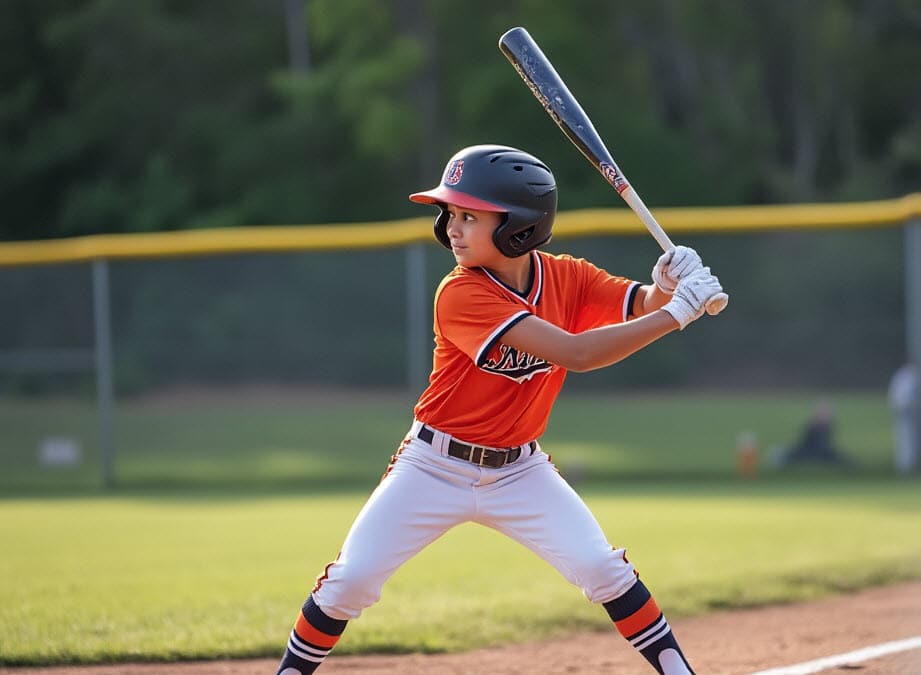
Timing is a Lie: Why the Best Hitters Focus on Pitch Patterns, Not Swing Speed
Did you know up to 90% of hitters swing early if not guided correctly, especially early in the season? This shows how crucial mastering swing timing is in baseball! At Hitting Performance Lab, we’re eager to share our skills with you. We offer game-tested batting drills and proven techniques to fix late swings quickly and boost your game.
We aim to equip you with the tools and knowledge for success. Our baseball drills for hitting will teach you about stride mechanics, recognizing pitches, and adapting your swing. You’ll see improvements in reaction time, pitch adjustments, and power, making you hit like a pro!
With our expert help, you’ll learn to spot and fix late swings. You’ll develop a more consistent and powerful swing. Our method is based on science and practical baseball teaching. We’re dedicated to debunking old myths and giving you the best techniques.
Key Takeaways
- Up to 90% of hitters exhibit early swing tendencies when not closely monitored…
- Game-tested batting drills can help you fix late swings fast and improve your reaction time…
- Proven batting techniques, such as stride mechanics and pitch recognition, are essential for mastering swing timing…
- Baseball drills for hitting can help you develop a more consistent and powerful swing…
- Our approach is centered around science-backed, practical baseball instruction…
- With our expert guidance, you’ll be able to identify and correct late swings and take your game to the next level…
- Our goal is to provide you with the tools and knowledge you need to succeed and start hitting like a pro…
Understanding Late Swing Mechanics and Their Impact
As a baseball or softball player, having a solid swing is key. But what if you swing late? It can be tough and hurt your batting average. To get better, knowing how late swings work and their effect is crucial. By adding effective hitting drills to your practice, you can improve your timing and skills.
Often, late swings come from inconsistent or flawed technique. This might be because of poor pitch recognition or not enough practice. To fix this, focus on batting practice drills that help you swing consistently. Using the best baseball swing drills can boost your timing and hard hit rate.
Here are some key statistics to consider:
- 8,000 pounds per square inch of force is needed to hit a baseball 400 feet, Matt Nokes said this.
- With practice, you can hit 120 feet farther – you get 4 feet of batted ball distance by adding 1-mph of ball exit speed.
- At higher levels, reaction time for hitters is under 0.4 seconds.
By understanding late swings and using effective hitting drills, you can elevate your game. Stay focused, practice regularly, and always look for ways to refine your technique.
Essential Equipment and Setup for Batting Practice
When you start with batting drills for power, having the right gear is key. You’ll need a batting tee, a hitting sock net or batting cage to hit in, and a bat the perfect bat or bats. Prices vary, with tees from $20 to $100, nets from $50 to $300, and bats from $30 to $150.
For top batting drills in baseball, the right tools are vital. Good drills start with a solid stance, grip, and alignment. With the right setup, you can practice your swing confidently and precisely. This helps you focus on power and advanced hitting.
Here are some essential items you’ll need:
- Batting Tee: $20 – $100
- Hitting Net: $50 – $300
- Weighted Bats: $30 – $150+
- Protective Gear: $20 – $100+
Investing in the right equipment and setup will help you master advanced hitting drills. Always focus on proper technique and safety. Don’t hesitate to try new drills for power and advanced hitting to improve your game.
| Equipment | Price Range |
|---|---|
| Batting Tee | $20 – $100 |
| Hitting Net | $50 – $300 |
| Weighted Bats | $30 – $150 |
| Protective Gear | $20 – $100+ |
Game-Tested Batting Drills for Quick Response Training
We’re excited to share our expertise with you. Our swing drills are the key to unlocking your full potential! These game-tested batting drills help you develop quick reflexes and improve your reaction to different pitches. By adding these drills to your practice, you’ll become a more confident and effective hitter.
Our baseball drills for hitting are based on proven techniques. They’ve been tested and refined over years of experience and research. Quick response training is key for improving your reaction time and pitch adjustments. Our drills are designed to help you achieve this, whether you’re a seasoned pro or just starting out.
Some of our favorite drills include (please watch video below):
- Rapid response tee work: This drill helps you develop your hand-eye coordination and reaction time, allowing you to quickly adjust to different types of pitches.
- Short-toss reaction drills: This drill simulates game-like situations, helping you develop your ability to react to fast-paced pitches and make quick decisions.
- High-velocity machine training: This drill helps you develop your ability to hit high-velocity pitches, which is essential for success at the highest levels of the game.
By incorporating these proven batting techniques into your practice routine, you’ll reach new heights in your game. So why wait? Start using our game-tested batting drills today and see the difference for yourself!
Unleashing Explosive Power with the Catapult Loading System
Building true power at the plate isn’t just about strength—it’s about mastering timing, body mechanics, and the right loading principles. The Catapult Loading System (CLS) is a revolutionary approach designed to help hitters—no matter their size—consistently drive the ball 300 feet or more.
Traditional hitting drills often fall short because they ignore the biomechanics behind elite-level power. Instead of relying on outdated cues like “squish the bug” or “swing down,” the CLS focuses on natural human movement principles backed by real science. This means better energy transfer, faster bat speed, and more consistent power.
Some of the game-changing drills in the Catapult Loading System include:
✅ The “Hiding Hands” Drill – Teaches hitters how to properly stretch and load their fascia for maximum energy storage before the swing.
✅ The “Springy Fascia” Drill – Helps hitters tap into their elastic energy system, just like high-velocity throwers and power lifters.
✅ The “Shoulder Down & In” Drill – Fixes common swing flaws and optimizes bat path for better barrel control.
Take a look at elite hitters like Mookie Betts or José Altuve—they may not be the biggest players, but they generate massive power through efficient mechanics, not brute force. The Catapult Loading System breaks down these mechanics step-by-step, so any hitter can replicate them.
By integrating CLS drills into your routine, you’ll:
⚾ Eliminate late swings and weak contact
⚾ Improve reaction time and pitch tracking
⚾ Unlock effortless power by optimizing your body’s natural movement patterns
If you’re serious about turning your young hitter into a consistent power threat, mastering the Catapult Loading System is non-negotiable. The science is clear, the results are proven—let’s start crushing baseballs the right way!
Advanced Pitch Recognition Techniques
We’re excited to help you get better at baseball. Our swing techniques and drills are key to unlocking your potential. To improve your batting, you need to learn advanced pitch recognition. This means using video analysis methods to study the pitcher’s movements and find patterns.
By doing this, you can guess the type of pitch and adjust your swing. This is crucial for success at the plate.
Here are some ways to improve pitch recognition:
- Live pitcher tracking drills to enhance your ability to read the pitcher’s body language and movement
- Mental preparation strategies to stay focused and composed under pressure
- Practicing batting practice drills and effective hitting drills to develop your skills and build confidence
By adding these techniques to your training, you’ll react faster and make better decisions at the plate. Remember, success comes from consistent practice and a willingness to learn. So, don’t hesitate to try new best baseball swing drills and push yourself to be your best!
Implementing Drills into Your Regular Practice Routine
To improve your batting, add game-tested drills to your practice. These drills boost your reaction time and power. Drills like the Controlling Verticals and Horizontals help you swing better and hit more often.
Focus on key techniques like loading and stride control. The Front Shoulder Down and In drill enhances your coil. The Hollowed Hold drill helps with safely loading the body. These drills make your swing more consistent, effective, and safe.
Here are tips for adding drills to your routine:
- Start with a weekly training schedule to ensure consistency and structure.
- Use progress tracking methods to monitor your improvement and identify areas for improvement.
- Adjust drills for your skill level to ensure you’re challenging yourself without becoming overwhelmed.
By following these tips and adding drills to your routine, you’ll improve your batting. Focus on proven techniques and adjust drills to fit your skill level. This way, you’ll keep getting better.
| Drill | Purpose | Effective for |
|---|---|---|
| Controlling Verticals | Improves line drive rate | Hitters who struggle with hitting more consistent line drives. |
| Controlling Horizontals | Focuses on pulling or going oppo effectively | Hitters with issues ONLY pulling the ball, or ONLY going oppo |
This is a video in the Swing Shift series…
Boost your hitting skills with Swing Shift’s science-backed practice system! This program is packed with features to improve hand path stability, timing, and power. Enjoy engaging drills for consistent progress and fun challenges to keep training exciting. Swing Shift is designed to help players succeed at every level.
The Swing Shift platform lets you focus on key mechanics like bat angle, balance, and hand path control. Dive into step-by-step video lessons that cover power, contact, and rhythm, breaking down the science behind a great swing. With personalized feedback and progress tracking, you can refine your technique and watch your results improve.
Whether you’re a youth athlete, high school player, or elite hitter, Swing Shift is trusted by families and coaches everywhere. Master core skills like bat control, weight transfer, and rotational power with drills designed for real game results. Start your journey to hitting greatness with Swing Shift!
Swing Shift’s practice system offers a wide range of tools to elevate your hitting:
- RNT-based drills for real-time correction
- Engaging challenges for competitive practice
- Personalized training goals and skill progression
- Exclusive videos on timing, power, and consistency
- Hands-on feedback to track and improve your swing mechanics
- Trusted by dedicated parents, players, and coaches
Reach your full potential with Swing Shift’s comprehensive practice system. Elevate your hitting with cutting-edge techniques and proven, science-based training.
Conclusion: Mastering Your Swing Timing for Game Day Success
Mastering your swing timing is key to success on the baseball field. Our batting drills for power and top batting drills for baseball will help you. You’ll get better at reacting to pitches and hitting the right spot.
Practicing our advanced hitting drills regularly will improve your skills. You’ll learn to hit solidly, even against fast pitches. With the right training, you’ll hit with more power and precision. So, start improving your swing today!
FAQ
What are the common causes of late swings?
Late swings often come from inconsistent swing techniques. They can also be due to poor pitch recognition or not practicing enough.
How do late swings affect my batting average?
Late swings can really hurt your batting average. They usually lead to weak or missed hits.
What is the science behind swing timing?
Swing timing science deals with how our body and brain work together. It’s about the complex coordination needed to time the swing right.
What essential equipment do I need for effective batting practice?
For good batting practice, you’ll need a tee, a batting net, and a bat. It’s also key to set up right, with the right stance, grip, and alignment.
What are the game-tested batting drills for quick response training?
Quick response drills include using a tee, short-toss drills, and training with high-velocity machines. These help you react fast.
How can I develop power through timing exercises?
To build power, try the snap and ride drills. They help you hit the ball hard and far.
What are the advanced pitch recognition techniques?
Advanced techniques include video analysis, tracking live pitchers, and mental prep. They help you see the ball better and adjust quickly.
How do I implement drills into my regular practice routine?
To add drills to your routine, make a weekly schedule. Use progress tracking and adjust drills based on your skill level.




















